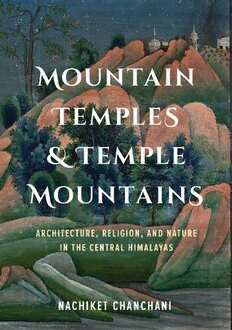
Mountain Temples and Temple Mountains: Architecture, Religion, and Nature in the Central Himalayas PDF
Preview Mountain Temples and Temple Mountains: Architecture, Religion, and Nature in the Central Himalayas
Padma Kaimal K. Sivaramakrishnan Anand A. Yang SerieS editorS Moun ta i n T e m pl e S & T e m pl e Moun ta i nS Architecture, r eligion, A nd nAture in the c entrAl h imAlAyAs nAchiket c hAnchAni UniverSity of WaShington PreSS Seattle Mountain Temples and Temple Mountains was made possible by a collaborative grant from the Andrew W. Mellon Foundation. Publication of this book was also aided by a grant from the Millard Meiss Publication Fund of the College Art Association. Additional support was provided by the College of Literature, Science, and the Arts and by the Charles Lang Freer Fund administered by the Department of the History of Art at the University of Michigan. Copyright © 2019 by the University of Washington Press Printed and bound in Korea Design by Katrina Noble Composed in Minion Pro, typeface designed by Robert Slimbach 23 22 21 20 19 5 4 3 2 1 All rights reserved. No part of this publication may be reproduced or transmitted in any form or by any means, electronic or mechanical, including photocopy, recording, or any information storage or retrieval system, without permission in writing from the publisher. UniverSity of WaShington PreSS www.washington.edu/uwpress library of CongreSS Cataloging- in- PUbliCation data lC record available at https://lccn.loc.gov/2018012494 jaCket deSign: Katrina Noble jaCket illUStration: Detail of Shiva Carrying the Corpse of Sati on His Trident. India, Him- achal Pradesh, Kangra, ca. 1800. Opaque watercolor and gold on paper. 11 ½ × 16 in. Los Angeles County Museum of Art (LACMA), purchased with funds provided by Dorothy and Richard Sher- wood, Mr. Carl Holmes, William Randolph Hearst Collection, and Mr. Rexford Stead (79.1). All interior photographs, fi gures, and maps are by the author unless otherwise noted. Th e frontispiece pictures a latina temple, ca. 750, at Lakhamandal, Uttarakhand. ∞ Th e paper used in this publication is acid free and meets the minimum requirements of American National Standard for Information Sciences—Permanence of Paper for Printed Library Materials, anSi Z39.48–1984. For my parents Rightly do they call your immovable form Viṣṇu, for your middle is the support of all beings, moving and unmoving. Kumārasaṃbhava 6.67 ContentS Acknowledgments ix Note on Transliteration xiii introdUCtion 3 ChaPter 1 Headed to the Himalayas 25 ChaPter 2 Gateways and Guardians 45 ChaPter 3 Śaiva Ascetics and Kings in a Flaming Forest 75 ChaPter 4 Great Temples and Little Kingdoms along the Vishnu Ganga River 113 ChaPter 5 New Seekers and Settlers 143 ConClUSion 173 Appendix: Temple Sites in India’s Central Himalayas 199 Glossary of Key Architectural Terms 209 Notes 213 Bibliography 239 Index 257 aCknoWledgmentS It is a pleasure to acknowledge the individuals and institutions who have made this book possible. By giving me the opportunity to create an archive of Stella Kramrisch’s papers, Darielle Mason helped shaped my interest in Indian and Himalayan art. She also introduced me to her teacher Michael W. Meister and to his profound scholar- ship. I am grateful to Michael for first leading me to mountain temples and temple mountains and for teaching me to read monuments and see texts. I would also like to thank Romila Thapar for teaching me to see the past as present and for interrogat- ing my reading of diverse genres of Sanskrit texts. My special thanks to Deven Patel for imparting expert training in the fundamentals of Sanskrit language and for his steadfast support. I fondly remember the late M. A. Dhaky, who affectionately showed me how to coordinate the archaeological record with the textual evidence, answered numerous questions, and gave me an important unpublished manuscript. For their roles as inspiring educators, I thank Frederick Asher, Catherine Asher, Partha Chatter- jee, Tapati Guha- Thakurta, Laura Hilton, Rhoda Van Tassel, and Richard Williamson. I have also learned a great deal from Crispin Branfoot, Ashok Das, Dayita Datta, Debra Diamond, Saryu Doshi, Devangana Desai, Suresh Dubey, Adam Hardy, Claire Har- ris, Deborah Klimburg- Salter, Nancy Mickelwright, Prayag Raj Sharma, Snehal Shah, Frederick Smith, A. Srivathsan, Nancy Steinhardt, Babu Suthar, Theodore Riccardi, Walter Spink, Tamara Sears, and Woodman Taylor. Residents of the Indian and Nepal Himalayas—too many to list here—led me through glens and meadows to commemorative markers, gatehouses, sculptures, tem- ples, and water- resource structures erected in centuries past. En route they regaled me with legends of their gods and guardians. Gautam Sengupta permitted me to measure and photograph monuments and sculptures protected by the Archaeological Survey of India (ASI). I am also grateful to many other ASI officers for facilitating my work. Rakesh Tewari shared recollections of his pioneering village- to- village surveys. He also allowed me to examine reserve collections of the Uttar Pradesh State Museum in Luck- now. Hari Chauhan permitted me to photograph sculptures in the State Museum in ix
